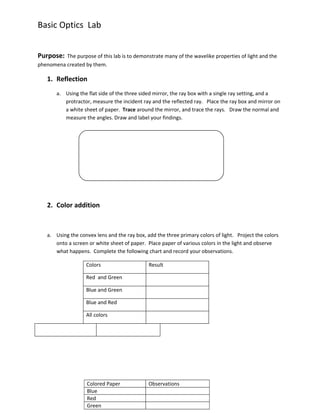
Optics lab 1
- 1. Basic Optics Lab Purpose: The purpose of this lab is to demonstrate many of the wavelike properties of light and the phenomena created by them. 1. Reflection a. Using the flat side of the three sided mirror, the ray box with a single ray setting, and a protractor, measure the incident ray and the reflected ray. Place the ray box and mirror on a white sheet of paper. Trace around the mirror, and trace the rays. Draw the normal and measure the angles. Draw and label your findings. 2. Color addition a. Using the convex lens and the ray box, add the three primary colors of light. Project the colors onto a screen or white sheet of paper. Place paper of various colors in the light and observe what happens. Complete the following chart and record your observations. Colors Result Red and Green Blue and Green Blue and Red All colors Colored Paper Observations Blue Red Green
- 2. 3. Refraction a. Observe a single refracted ray through the trapezoid-shaped prism. Place the ray box and prism on a white sheet of paper. Trace around the prism and trace the rays.Record all angles of incidence and refraction. Using Snell’s Law, calculate the index of refraction. Show your calculations: ______________ n = Sin Ǿi / SinǾr 4. Dispersion a. Using the trapezoid-shaped prism and a single ray of light, adjust the angle of refraction into and out of the point of the prism so that it causes the light to disperse into the various colors. Project the colors onto a screen or white sheet of paper. Describe what you see and the order of the colors. 5. Concave/Convex Mirror Introduction a. Using the ray box with several parallel beams incident upon the CONCAVE mirror, observe what occurs. Locate the focal point. Sketch this observation. b. Using the ray box with several parallel beams incident upon the CONVEX mirror, observe what occurs. Locate the focal point. Sketch this observation. 6. Concave/Convex Lens Introduction a. Using the ray box with several parallel beams incident upon the CONVEX lens, observe what occurs. Locate the focal point. Sketch this observation. b. Using the ray box with several parallel beams incident upon the CONCAVE lens, observe what occurs. Locate the focal point. Sketch this observation.
- 3. Objective: 1. Reflection Draw and label your diagram with the angle measurement of incidence and reflection rays…. What is law of reflection? 2. Color Addition: Complete the table. Colors Combined Result Red and Green Blue and Green Blue and Red All colors
- 4. Colored Paper Observations Blue Red Green What is visible light? 3. Refraction. Draw what happened. Label the angle of incidence and the angle of refraction. Solve for n? Give your complete solution. n = Sin Ǿi / SinǾr 4. DISPERSION. Sketch what you have observed and give the arrangement of colors in order. 5. Concave and Convex MIRROR. Just draw your observation and the location of the FOCAL POINT (F). You can refer to your book on page 421 and 426 6. Concave and Convex Lens. Just draw your observation and the location of the FOCAL POINT (F). You can refer on page 434 and 435.
